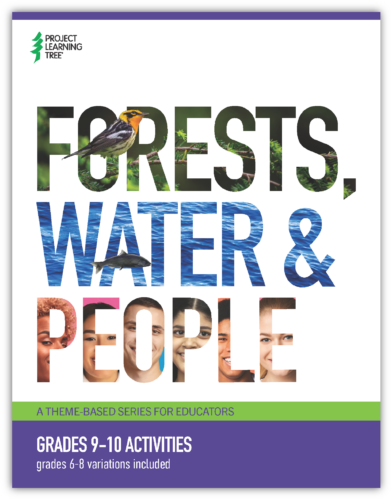November 5, 2024
 Project Learning Tree is excited to share that we’ve expanded our high school-focused instructional materials with a brand-new digital activity collection! Forests, Water & People includes three place-based lessons that invite learners to explore how trees, watersheds, and our communities are interrelated. The collection is designed for educators to use with learners in grades 9-10, with variations for grades 6-8.
Project Learning Tree is excited to share that we’ve expanded our high school-focused instructional materials with a brand-new digital activity collection! Forests, Water & People includes three place-based lessons that invite learners to explore how trees, watersheds, and our communities are interrelated. The collection is designed for educators to use with learners in grades 9-10, with variations for grades 6-8.
This special collection was developed in collaboration with the USDA Forest Service.
The Journey of a Single Drop of Water
When you think about where your drinking water comes from, what comes to mind? Rivers, streams, or natural springs?
What about forests?
Be-leaf it or not, we rely on forests for high-quality drinking water! When rain falls on forests, the layers of vegetation slow and collect the rainwater, enabling it to slowly seep into the soil to recharge streams, rivers, and aquifers. The more forested a watershed is, the better it can maintain water quality. You can thank a tree the next time you quench your thirst with ice-cold water!
Open students’ eyes to the source of their water and help them explore how their community’s water supply depends on forested lands.
Explore Your Community
 When it comes to making learning even more relevant, place-based lessons are the perfect way to incorporate what’s happening in your local environment. Plus, learners get to utilize GIS maps and technology as a way to learn about nature!
When it comes to making learning even more relevant, place-based lessons are the perfect way to incorporate what’s happening in your local environment. Plus, learners get to utilize GIS maps and technology as a way to learn about nature!
The three lessons can be taught as standalone activities or linked together into a unit of instruction using a storyline:
Activity 1: From Tap Root to Tap Water
Introduce the concept of watersheds as a critical source of drinking water and challenge students to map out their local watersheds, indicating the location of any forestlands. Familiarize them with the Forests to Faucets 2.0 tool created by the USDA Forest Service to further deepen their knowledge about their watershed.
Activity 2: Mapping Your Community Through Time
Explore how a local community has changed over time in terms of its housing, water systems, and green spaces, including forests. Encourage students to look for ways that changes in these community components are connected.
Activity 3: Watershed Watch
Invite students to explore a forest-related watershed issue from different stakeholder perspectives and then to plan and conduct an action project that helps resolve a local watershed problem or maintain local water quality.
Learn more about the collection: https://www.plt.org/forests-water-people-activity-collection/
Additional Theme-Based Lessons
PLT’s downloadable activity collections can be used as standalone activities or cohesive units of instruction that follow a storyline. Containing three to four lessons, they can easily integrate into your existing curriculum or programming, enhancing multidisciplinary learning. PLT incorporates a variety of subjects into every activity, so learners are exposed to science, math, language arts, social studies, art, technology, and more—all the while learning about our environment!
High School
Middle School
Elementary School
Grades K-2
Grades 3-5



